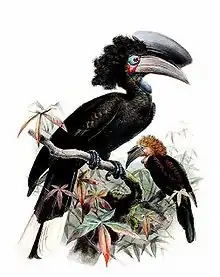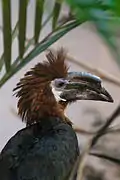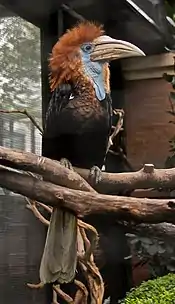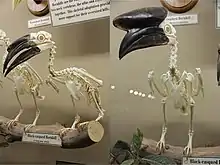Ceratogymna
Ceratogymna is a genus of large, primarily frugivorous hornbills (family Bucerotidae) found in the humid forests of Central and West Africa. They are sexually dimorphic: males are all black, while females have brown heads and a smaller casque.[1] Unlike the members of the genus Bycanistes, the two species in the genus Ceratogymna have extensive, primarily blue, bare facial skin and dewlap, and the only white in their plumage is in the tail (although the yellow-casqued wattled hornbill has slight whitish speckling on the neck).
| Ceratogymna | |
|---|---|
 | |
| Black-casqued hornbill (Ceratogymna atrata) | |
| Scientific classification | |
| Kingdom: | Animalia |
| Phylum: | Chordata |
| Class: | Aves |
| Order: | Bucerotiformes |
| Family: | Bucerotidae |
| Genus: | Ceratogymna Bonaparte, 1854 |
| Species | |
|
2, see text. | |
Species
| Image | Scientific name | Common Name | Distribution |
|---|---|---|---|
 | Ceratogymna atrata | Black-casqued hornbill | Angola, Cameroon, Central African Republic, Republic of the Congo, Democratic Republic of the Congo, Ivory Coast, Equatorial Guinea, Gabon, Ghana, Guinea, Liberia, Nigeria, Sierra Leone, South Sudan, Togo, and Uganda. |
 | Ceratogymna elata | Yellow-casqued hornbill | West Africa |

Skeletons of female (left) and male (right) black-casqued hornbills, showing the sexual dimorphism present on their bills. (Museum of Osteology)
The members of the genus Bycanistes have been included in this genus, but today most authorities consider the two separate.[1]
References
- Kemp, A. C. (2001). Family Bucerotidae (Hornbills). Pp. 436-523 in: del Hoyo, J., Elliott, A., & Sargatal, J. eds. (2001). Handbook of the Birds of the World. Vol. 6. Mousebirds to Hornbills. Lynx Edicions, Barcelona. ISBN 84-87334-30-X
This article is issued from Wikipedia. The text is licensed under Creative Commons - Attribution - Sharealike. Additional terms may apply for the media files.